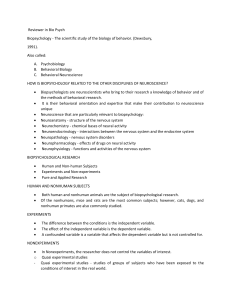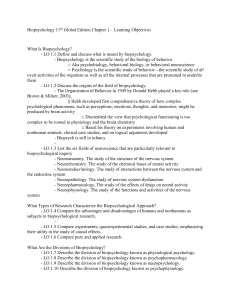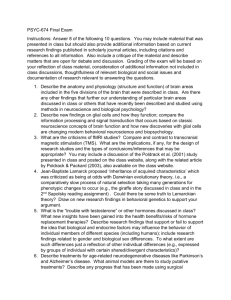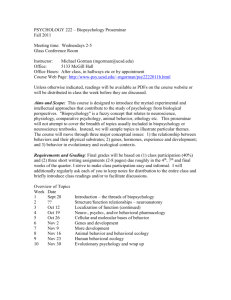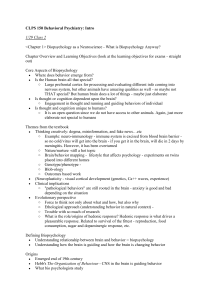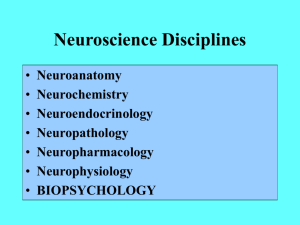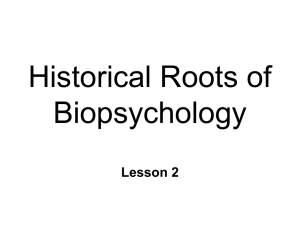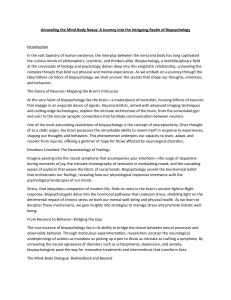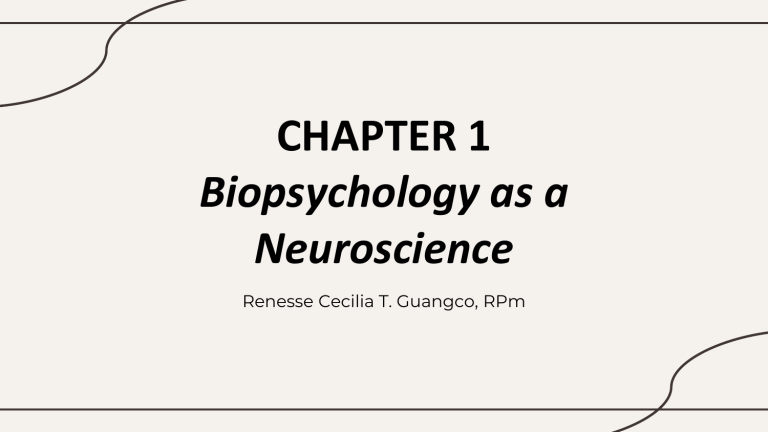
CHAPTER 1 Biopsychology as a Neuroscience Renesse Cecilia T. Guangco, RPm The Human Brain Neuroscience Is the scientific study of the nervous system. It has several disciplines and one of them is: biopsychology. 01 What is Biopsychology? Biopsychology ● Is the scientific study of the biology of behavior. ● Some refer to this field as: psychobiology, behavioral biology, behavioral neuroscience. Donald O. Hebb ● D.O. Hebb in 1949 had played a key role in the emergence of biopsychology through his book: The Organization of Behavior (theories on perceptions, emotions, thoughts, memories, that might be produced by brain activity). How is Biopsychology is related to other disciplines of Neuroscience? Neuroscience is a team effort. Biopsychology is an integrative discipline that can be further be explained by its relation to other neuroscientific disciplines such as: ○ Neuroanatomy – study of the structure of the nervous system ○ Neurochemistry – study of the chemical bases of neural activity ○ Neuroendocrinology – study of interactions between the nervous and endocrine system How is Biopsychology is related to other disciplines of Neuroscience? ○ ○ ○ Neuropathology – study of the nervous system disorders Neuropharmacology – the study of the effects of drugs on neural activity Neurophysiology – the study of functions and activities of the nervous system 02 What types of research characterize the Biopsychological Approach? What types of research characterize Biopsychological approach? Biopsychological approach can involve human or nonhuman subjects, can be formal experiments or non experimental studies, and it can be pure or applied. Human and Nonhuman Subjects Nonhuman Subjects • • • • • • Human Subjects Mice and rats are common subjects. • Cats, dogs, and nonhuman primates • as well. • Cost of maintaining an animal laboratory can be prohibitive. Brain and behavior are simpler Nonhuman subjects gives more insight and rise to comparative approach Fewer ethical constraints than human subjects Can follow instructions Can report subjective experiences Often cheaper Experiments and Nonexperiments Experiments Nonexperiments • • • • • • Focus is on cause and effect Utilizes between-subjects and/or within-subjects design IV is the difference between conditions. DV is measured to assess the effect of the IV. • • or Quasiexperimental studies Happens when studies have been exposed to the conditions of interest in the real world. Case Studies studies that focuses on a single case or subject. There is a problem with generalizability. Pure and Applied research Pure Research Applied Research • • Is motivated primarily by the curiosity of the researcher- done solely for the purpose of acquiring knowledge. Is intended to bring about some direct benefit to human kind. TRADITIONAL RESEARCH - a research that aims to translate the findings of pure research into useful applications for human kind. 03 What are the Divisions of Biopsychology? What are the divisions of Biopsychology? Physiological Psychology – studies the neural mechanisms of behavior through the direct manipulation and recording of the brain in controlled experiments. ● Surgical and electrical methods are common. ● Subjects are almost always laboratory animals. Psychopharmacology Psychopharmacology focuses on the manipulation of neural activity and behavior with drugs. ● Many early psychopharmacologists were physiological psychologists. ● Common purpose is to develop therapeutic drugs. Neuropsychology Neuropsychology is the study of psychological effects of brain damage in human patients. ● They deal almost exclusively with case studies and quasiexperimental studies. ● The cerebral cortex is most likely damaged (in this case) by accident or surgery. Psychophysiology Psychophysiology studies the relation between physiological activity and psychological processes in human subjects. ● Procedures are typically noninvasive. (it is recorded from the surface of the body) ● Examples are EEG (electroencephalogram), muscle tension, eye movement (ANS – autonomic nervous system activity. Cognitive Neuroscience Cognitive Neuroscience is the youngest division of biopsychology. They study the neural bases of cognition. ● Cognition refers to higher intellectual processes such as thought, memory, attention, and complex perceptual processes. ● Commonly involves human participants and methods are noninvasive. Comparative Psychology Comparative Psychologists compare the behavior of different species in order to understand the evolution, genetics, and adaptiveness of behavior. ○ Ethological research – the study of animal behavior in its natural environment. ○ Evolutionary psychology – focuses on understanding behavior by considering its likely evolutionary origins. ○ Behavioral genetics – the study of genetic influences on behavior. 04 How do Biopsychologists conduct their work? How do Biopsychologists work together? Major biopsychological issues are rarely resolved by a single experiment or even by a single series of experiments taking the same general approach. The combined approach is called Converging operations. How do biopsychologists study the unobservable workings of the mind? Scientific inference is the fundamental method of biopsychology and most other sciences. It is the empirical method that biopsychologists and scientists use to study the unobservable. End. CREDITS: This presentation template was created by Slidesgo, including icons by Flaticon,and infographics & images by Freepik Please keep this slide for attribution
